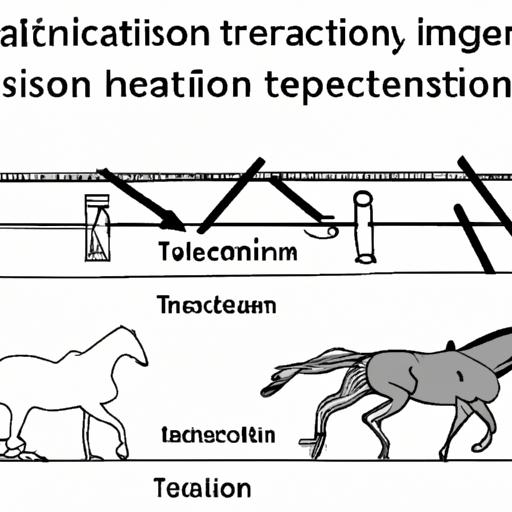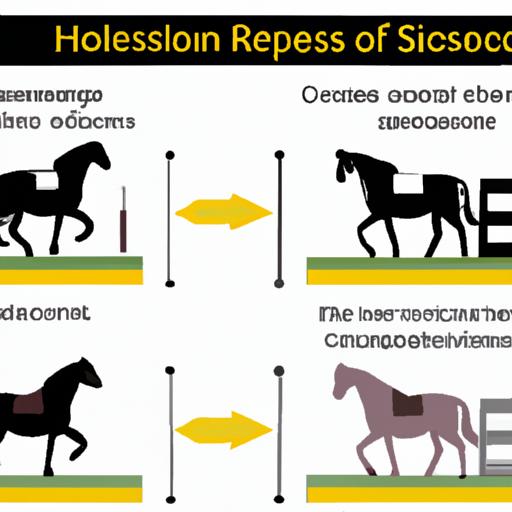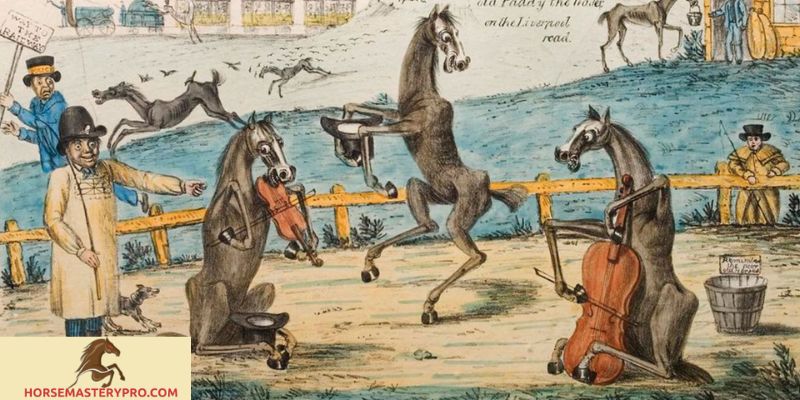Discover the safety measures & regulations to prevent horse-train collisions. Learn about fencing, signage, train horns, laws, and speed limits.
Have you ever wondered what happens when a majestic horse collides with a massive train? The incident of a horse getting hit by a train is not only tragic but also raises crucial questions about safety and the well-being of both animals and humans. In this article, we will delve into the details of such an unfortunate event, shedding light on its implications and the necessity of prevention.
Picture this: a peaceful countryside, a serene railway track, and a horse grazing nearby. Suddenly, the tranquility is shattered by the thunderous roar of a train hurtling down the tracks. Unfortunately, the horse fails to escape the impending danger, resulting in a catastrophic collision. This incident serves as a stark reminder of the potential risks associated with railway lines and the critical need for vigilance.
Understanding the implications of a horse-train collision is essential for several reasons. Firstly, it highlights the vulnerability of both horses and humans in such situations. These incidents can lead to severe injuries and even fatalities, not only for the horse but also for train passengers and operators. The emotional trauma experienced by witnesses and train personnel cannot be overlooked either, as it leaves a lasting impact on their well-being.
The incident also draws attention to existing safety measures and regulations. Fencing and proper signage along railway tracks, combined with effective train horns and warning systems, play a vital role in preventing accidents. However, it is crucial to analyze whether these measures are implemented consistently and if any additional regulations need to be enforced. Join me in the next section as we explore the safety measures and regulations in place to prevent horse-train collisions.
Remember, the safety of horses, train passengers, and operators should never be compromised. By understanding the gravity of these incidents and the implications they entail, we can collectively work towards creating a safer environment for everyone involved. Stay tuned as we delve deeper into this topic and discuss the existing safety measures and regulations in Section Together, we can make a difference and prevent such tragic accidents from occurring.
Understanding the Accident

Accidents involving horses and trains are heart-wrenching, and gaining a detailed understanding of how such incidents occur is essential to prevent future tragedies. Let’s dive into the specifics of a horse-train collision and the factors that contribute to these accidents.
A. Detailed Account of How the Horse Got Hit by the Train
To comprehend the dynamics of a horse-train collision, we need to envision the sequence of events leading up to the unfortunate incident. Picture a picturesque countryside with vast open fields, where horses roam freely. In this scenario, a horse unknowingly wanders onto the railway track, potentially attracted by nearby vegetation or simply by curiosity. As the train approaches at high speed, its massive size and noise can startle the horse, leaving it disoriented and unable to escape the imminent danger. The collision occurs, resulting in devastating consequences for both the horse and the train.
B. Factors Contributing to the Accident
While the horse-train collision may seem like a sudden and unpredictable event, certain factors contribute to its occurrence. Let’s examine the key elements that play a significant role in these unfortunate accidents.
1. Location and Visibility
The location of the railway track and its surroundings can greatly impact the likelihood of a horse-train collision. Tracks running close to areas with high horse activity, such as pastures or trails, heighten the risk. Poor visibility due to natural landscape features, vegetation overgrowth, or inadequate lighting can also make it challenging for both horses and train operators to detect each other in time.
2. Train Speed and Warning Signals
The speed at which trains travel is another crucial factor in horse-train collisions. Faster-moving trains have a shorter reaction time, leaving little room for avoidance or escape. Additionally, the effectiveness of warning signals, such as train horns or bells, can determine whether a horse has enough time to react and move away from the tracks. In some cases, malfunctioning or insufficient warning systems can contribute to the tragic outcome.
Understanding these contributing factors is essential for implementing effective preventive measures. In the next section, we will explore the safety measures and regulations that can reduce the occurrence of horse-train collisions. Together, we can work towards creating a safer environment for both horses and trains.
Consequences of Horse-Train Collisions

A. Impact on the Horse and its Well-being
When a horse collides with a train, the consequences can be devastating. The impact alone can cause severe injuries, ranging from fractures and internal bleeding to head trauma and spinal damage. The well-being of the horse is compromised, often resulting in prolonged suffering and the need for immediate veterinary attention. The physical pain and trauma experienced by the animal can be unimaginable, leaving a lasting impact on its overall health and quality of life.
B. Potential Injuries and Fatalities for both Humans and Animals
Horse-train collisions not only pose a significant risk to the horses involved but also put humans in danger. Train passengers and operators may sustain injuries or even lose their lives in such accidents. The sheer force of a train colliding with a large animal like a horse can cause derailments, resulting in multiple casualties. Additionally, pedestrians and motorists near the railway tracks may also be at risk if a collision occurs unexpectedly.
Not only are humans and horses at risk, but other animals near the tracks can also be affected. Wildlife or livestock that wander onto the railway lines face the same potential dangers. The consequences of these collisions are a somber reminder of the need for increased awareness and preventive measures.
C. Emotional and Psychological Effects on Witnesses and Train Operators
The emotional and psychological toll of witnessing a horse-train collision should not be underestimated. Those who witness such tragic events may experience trauma, feelings of helplessness, and grief. Train operators, who are often unable to avoid such accidents due to the speed and size of trains, may suffer from post-traumatic stress disorder (PTSD) and other mental health challenges. The lasting impact on their mental well-being cannot be overlooked, highlighting the need for support and resources for these individuals.
The consequences of horse-train collisions extend far beyond physical injuries and fatalities. The emotional and psychological effects on witnesses and train operators serve as a stark reminder of the importance of implementing effective preventive measures. In the next section, we will explore the steps that can be taken to avoid such collisions and protect the well-being of all involved parties. Join me in Section V as we discuss preventive measures and strategies to minimize these tragic incidents.
Preventive Steps for Avoiding Horse-Train Collisions

As the saying goes, “Prevention is better than cure,” and this holds true when it comes to avoiding horse-train collisions. To ensure the safety of horses, passengers, and train operators, it is crucial to take proactive measures. In this section, we will explore some preventive steps that can be implemented to mitigate the risks of such accidents.
A. Education and Awareness Campaigns for Horse Owners
One of the key aspects of preventing horse-train collisions is educating horse owners about the potential dangers and best practices. By raising awareness, we can empower horse owners to take necessary precautions. Here are a couple of essential steps that should be highlighted:
1. Proper Fencing and Secure Enclosures
Creating a safe environment for horses is paramount. Horse owners must ensure that their properties are equipped with sturdy fencing and secure enclosures. This prevents horses from wandering onto railway tracks and coming into harm’s way. By implementing proper fencing, horse owners can significantly reduce the chances of a tragic collision.
2. Importance of Keeping Horses Away from Railway Tracks
Horse owners must understand the importance of keeping their horses at a safe distance from railway tracks. Horses are naturally curious animals and may be enticed to explore unfamiliar territories. By emphasizing the significance of keeping horses away from railway lines, owners can minimize the risk of accidents and protect the well-being of their beloved equines.
B. Collaboration between Railway Companies and Local Authorities
Besides education, collaboration between railway companies and local authorities is crucial in preventing horse-train collisions. By working together, they can implement effective safety measures. Let’s delve into two significant steps that can be taken:
1. Regular Maintenance of Tracks and Removal of Vegetation
Railway companies should prioritize the regular maintenance of tracks to ensure optimal visibility and prevent any obstructions that may attract horses. Clearing vegetation near railway lines is essential as it reduces the chances of horses straying onto the tracks. By keeping the tracks well-maintained and free from vegetation, the risk of collisions can be significantly reduced.
2. Implementing Additional Safety Measures
Railway companies and local authorities should collaborate to identify and implement additional safety measures. This could include the installation of warning signs, enhanced fencing along vulnerable stretches, and advanced technologies to detect and deter horses from accessing railway tracks. By taking proactive steps, we can create a safer environment for both horses and trains.
Preventing horse-train collisions requires a collective effort from horse owners, railway companies, and local authorities. By raising awareness, implementing preventive measures, and fostering collaboration, we can minimize the occurrence of these tragic accidents. Join me in the next section as we conclude our exploration and emphasize the importance of prioritizing safety for all stakeholders involved.
Conclusion: Prioritizing Safety and Responsibility to Prevent Horse-Train Collisions
As we conclude our exploration of the unfortunate incident where a horse was hit by a train, it becomes evident that the safety and well-being of both horses and humans should be paramount. The implications of such collisions are far-reaching, necessitating a proactive approach towards prevention and awareness.
The incident serves as a stark reminder of the need for collaboration between horse owners, railway companies, and local authorities. Education and awareness campaigns play a crucial role in ensuring horse owners understand the importance of proper fencing and secure enclosures to keep their horses away from railway tracks. Responsible horse ownership not only safeguards the animals but also prevents potential accidents that could have devastating consequences.
Furthermore, it is imperative for railway companies to prioritize safety measures and adhere to relevant regulations. Regular maintenance of tracks, including the removal of vegetation, ensures clear visibility and minimizes the risk of collisions. Additionally, implementing additional safety measures such as improved signage and warning systems can provide early alerts to both train operators and animals near the tracks.
Relevant regulations surrounding animal control near railway lines should be rigorously enforced. Clear laws and guidelines can help prevent horses from straying into dangerous areas and reduce the likelihood of accidents. Similarly, train speed limits and restrictions must be adhered to, ensuring sufficient time for train operators to react and avoid collisions.
In conclusion, the incident of a horse getting hit by a train sheds light on the need for continuous efforts in preventing such accidents. By prioritizing safety measures, raising awareness, and enforcing regulations, we can create a safer environment for both horses and humans. Let us unite in our commitment to responsible horse ownership and railway safety. Remember, Horsemasterypro.com is here to support you in your journey towards a safer and more harmonious coexistence between horses and trains. Together, we can make a significant difference.


